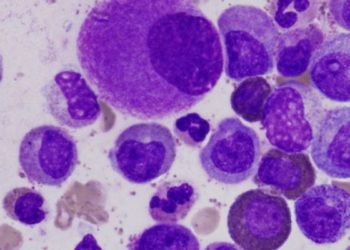Small-molecule drug reduces chemoresistance of chronic myelogenous leukemia cells [PreClinical]
1. The compound ICG-001 sensitized chemoresistant leukemia-initiating cells (LICs) to Imatinib (IM) and inhibited their ability to survive and proliferate.
2. In mice, combined treatment of ICG-001 with Nilotinib led to reduced cancer cell growth and improved survival.
Evidence Rating Level: 2 (Good)
Study Rundown: Chronic myelogenous leukemia (CML) cells are characterized by the production of a fusion oncoprotein, BCR-ABL. While earlier stages of CML have successfully been treated in the clinic using small-molecule inhibitors of BCR-ABL such as IM and Nilotinib, more advanced stages of the disease often become insensitive to such chemotherapeutics especially following treatment discontinuation. This refractory behavior is often attributed to the persistence of LICs, cells typically low in BCR-ABL levels. In this work, researchers used the compound ICG-001 to sensitize the LIC population to the BCR-ABL inhibitors in order to improve treatment efficacy.
The authors used patient-derived, IM-resistant cell populations rich in LICs to show that treatment with ICG-001 increases overall levels of BCR-ABL. When used in combination with IM, ICG-001 decreased the survival and proliferative capabilities of both LICs and inhibitor-sensitive cells. In a mouse model of CML, combination therapy using ICG-001 and Nilotinib halted cancer proliferation even 40+ days after treatment was stopped and significantly improved rate of survival as compared to the Nilotinib monotherapy cohort. Importantly, the experiment showed that production of normal hematopoietic cells was unaltered by ICG-001/Nilotinib treatment relative to healthy, untreated animals.
This study validates a promising therapeutic paradigm for CML treatment. In fact, a Phase 1a clinical trial using a compound similar to ICG-001 in combination therapy has recently been completed, though results of the trial are not yet available.
Click to read the study in Oncogene
Relevant Reading: Granulocyte–macrophage progenitors as candidate leukemic stem cells in blast-crisis CML
In-Depth [animal study]: This work evaluated the efficacy of the compound ICG-001 to render a chemoresistant CML cell population sensitive to the BCR-ABL inhibitors IM and Nilotinib. In initial in vitro experiments, patient-derived CML cells were treated with IM to produce IM-resistant cells. When treated with ICG-001, the resistant cells showed significantly higher BCR-ABL expression compared to control cells (p<0.01). Next, IM-sensitive and IM-resistant patient-derived CML cells that were treated with both ICG-001 and IM showed lower cell viability and proliferation compared to controls.
To test the effects of ICG-001 in vivo, a luciferase-tagged K562 (IM-sensitive) CML cell line was used for transplantation into the bone marrow of 15 NOD/SCID/IL2Rγ−/− (NSG) mice. Mice were treated with PBS (negative control), Nilotinib (100 mg/Kg/day), or ICG-001 (50 mg/Kg/day) and Nilotinib. Unlike animals in the control group, mice receiving a drug treatment did not show any growth of K562 cells after 28 days. Once treatment was stopped, mice in the monotherapy group showed an increase in cancer burden whereas the combination-treated group continued to survive with baseline K562 levels, as measured by luciferase signal. Mice treated with both compounds ultimately survived as long as their healthy, untreated littermates, living up to twice as long as the Nilotinib-only group (p=0.0018). A hematopoietic profile of red blood cell, white blood cell, platelet, and hemoglobin levels was used as a test of treatment toxicity towards normal hematopoietic cell differentiation processes, and animals with ICG-001/Nilotinib treatment showed levels comparable to healthy controls. Finally, two different primary patient samples of CML were transplanted into NSG mice and survival studies showed similar results as before, with combination therapy animals surviving significantly longer than Nilotinib monotherapy mice (p<0.05).
Image: PD
©2015 2 Minute Medicine, Inc. All rights reserved. No works may be reproduced without expressed written consent from 2 Minute Medicine, Inc. Inquire about licensing here. No article should be construed as medical advice and is not intended as such by the authors or by 2 Minute Medicine, Inc.







